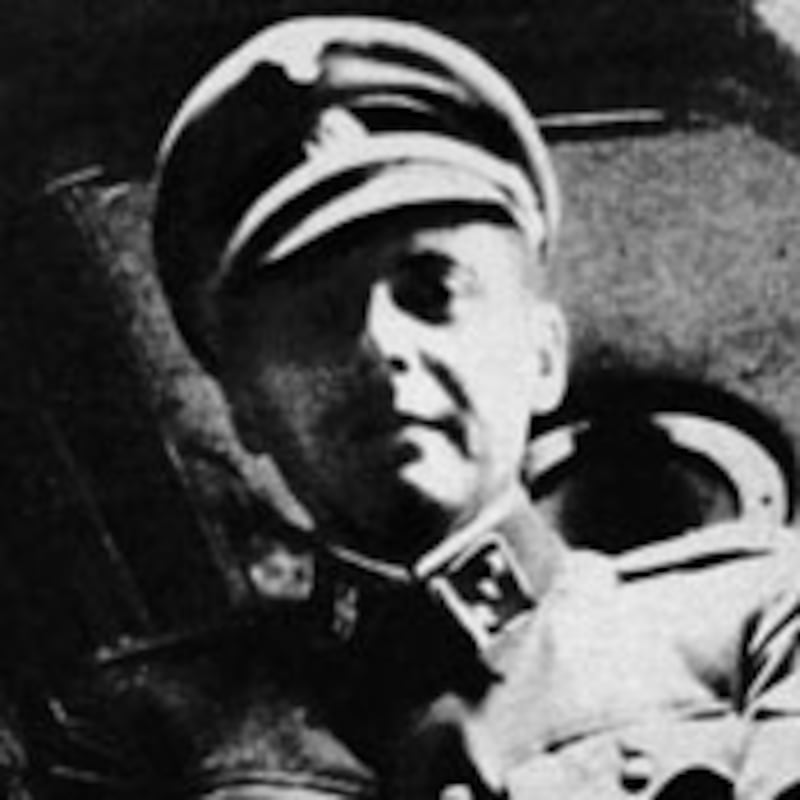
Josef Mengele, an SS physician posted to the largest Nazi death camp, Auschwitz, earned the moniker “the Angel of Death.” It was at the railhead selections, where hundreds of thousands of new arrivals, mostly Jews, stepped off squalid railroad box cars into glaring lights, lines of SS troops, and dozens of barking German shepherds, that the 33-year-old Mengele established his brutal reputation. There, immaculately dressed in his captain’s uniform, his black boots glistening, wearing white gloves, and often carrying a polished cane and whistling an operatic air, Mengele had the prisoners paraded before him. He pointed his cane at each. Softly spoken, sometimes smiling, he said only, “right” or “left.” The left line meant immediate death in the gas chambers. Right meant a brutal and often short-lived existence in the “work” camp, slave labor that usually ended in the gas chamber when stronger prisoners arrived.
He used the selections to weed out twins, and at his height at Auschwitz, he had had nearly 1,500 sets of twins under his control.
But Mengele didn’t earn his singular title only from the selections. He used the selections to weed out twins, and at his height at Auschwitz, he had had nearly 1,500 sets of twins under his control. Most were children on whom he conducted brutal and inhumane experiments. Although Mengele took his medical records with him when he fled Auschwitz in January 1945, just ahead of the incoming Russian troops who liberated the camp, it’s been possible to determine what he was trying to do with his injections of dyes into eyes, radiation infusions that left organs permanently burned, crude surgery on vocal cords, and dozens of other seemingly bizarre experiments. For a biography I co-wrote in 1986, Mengele: The Complete Story, I was one of the few people who had unrestricted access to Mengele’s thousands of pages of postwar diaries and his hundreds of pages of letters to his family. I also conducted dozens of hours of interviews with everyone from his only son, Rolf, to SS doctors and inmate physicians who served with Mengele at Auschwitz.
ADVERTISEMENT
• Abigail Pogrebin on Dr. Mengele's TwinsMengele considered himself a pioneer, at the forefront of Nazi race eugenics, and he thought that his work on twins would make him famous for two breakthroughs. He would first unlock the secrets of how to turn “inferior” races of Jews, Slavs, gypsies, and others into Aryan lookalikes. Hence the injections that were intended to turn dark eyes blue and change black hair to blond. But Mengele’s most ambitious goal was to unlock the still-unknown secret of twin births, and in so doing, ensure that every good German mother had two children at every birth instead of just one. In this way, Mengele would be credited with replenishing the German war dead at double the rate.
So it is little wonder there was great interest this year when a self-proclaimed Argentine historian, Jorge Camarasa, published a book, Mengele: The Angel of Death in South America, in which he claimed he had discovered a Brazilian town with an inordinately high number of twin births, and more astonishing, that those were the result of Mengele himself having continued his Nazi experiments there during the early 1960s. The town, Candido Godoi, has only 6,000 residents, or about 80 families. There are 44 sets of twins there, about 1,000 percent above the worldwide average for twin births. Residents told Camarasa that a German doctor they identified as Mengele had started his work there in 1963. The book’s contentions garnered international headlines, with most reports accepting the story as true. “Nazi angel of death Josef Mengele ‘created twin town in Brazil,’” was typical of a banner headline that ran in the U.K.’s Telegraph. National Geographic Explorer investigated the story in a documentary that first aired Sunday night.
The problem with Camarasa’s claims is that it’s not possible. At the time Mengele was supposed to be continuing his camp experiments in Candido Godoi, he was hundreds of miles away, hiding on an isolated farm, and not traveling. However, after following the Mengele story for 25 years, I know that simple truth never stops a sensational postwar Mengele story from making the rounds. The 1978 Hollywood film Boys from Brazil portrayed Mengele as a mythical figure of evil, a Nazi who went on to lead the Fourth Reich from his palatial jungle hideout, protected by armed guards and killer dogs, working hard to create clones of Adolf Hitler. In my own Nazi-hunting trips to South America, I met many well-intentioned people who said they had known Mengele, gone bowling with him, traveled recently with him, all sorts of wonderful and sometimes hair-raising tales. None proved true. An Argentine police captain wrote a book claiming he shot Mengele to death in a swamp near a secret jungle haven for Nazis. When I showed him incontrovertible proof that Mengele was alive after that encounter, the policemen didn’t miss a beat: “Then I must have killed his identical twin.”
The real Mengele was far more prosaic and mundane a fugitive than Hollywood and most storytellers would have us believe. Mengele lived in Germany, under an assumed name, in a southern farm, for four years after the war. I found the original documents in 1985 that revealed American troops had twice captured him in the hectic months after the war, but released him both times without realizing who he was.
It wasn’t until 1949, as other physicians were being tried and convicted in the so-called Doctors Trials, that Mengele’s wealthy industrial family paid for him to flee Europe on a fake Red Cross passport. He settled in pro-Nazi Argentina, and for the next decade he enjoyed a great life. Mengele was a regular at the Colón Opera, he started a farm-machinery company as an outlet for his family’s products, and later invested in a small pharmaceutical firm. The fugitive married his sister-in-law after one of his brothers died, and in 1956 he traveled to Switzerland for a skiing holiday. There he met his 12-year-old son Rolf; Mengele was introduced as “Uncle Fritz.”
When he returned to Argentina, Mengele felt so comfortable that no one was looking for him, that he applied to an Argentine court to use his real name instead of the alias under which he arrived in the country. He also got a West German passport as Josef Mengele. And by 1958, he felt so comfortable that he was listed under his real name in the Buenos Aires telephone book.
Everything changed in 1959. That June he was officially indicted by West German authorities for 17 counts of premeditated murder. (Before that indictment, there was, incredibly, no legal document seeking Mengele’s arrest.)
Mengele moved across the border to Paraguay, where he got citizenship under the name Jose Mengele. But that stay was short-lived; in May 1960, Adolf Eichmann, the Nazi bureaucrat who had run the section responsible for the trains that sent millions of Jews to the death camps, was run to ground and seized in Buenos Aires by Israeli agents. Eichmann was spirited to Israel, where he was eventually tried, convicted, and hanged.
Eichmann’s kidnapping sent Mengele, and other Nazi fugitives in South America, into a panicked frenzy. Mengele had good reason to be worried. As I disclosed in my 1986 book, the Israelis had wanted to pick up Mengele at the same time they nabbed Eichmann, but they were unable to find him. After Eichmann’s capture, they kept looking for Mengele for two years, and finally located him on an isolated farm in Brazil, before having to abandon the operation because of Middle East crises that threatened the very existence of the Israeli state.
Interviews with the Israeli operatives on his trail, combined with Mengele’s own contemporaneous diaries and letters to his family, prove incontrovertibly that during the time he was supposed to be doing twin experiments in Candido Godoi, he was hiding on a 37-acre farm near Nova Europa, 200 miles southwest of Sao Paulo. There he stayed with a pro-Nazi Hungarian family, living under the name Peter Hochbichler. He now spent most every day in the farm’s watchtower, scanning the approaching dirt roads with a pair of binoculars, trying to spot his hunters before they found him.
Until his 1979 death of a stroke, while swimming off the shore of Bertioga, a Brazilian beach just south of Sao Paolo, Mengele lived as a frightened and bitter man. He was simultaneously furious that he had to hide in multicultural and racially mixed Brazil, and he also was petrified that he would be unmasked as the wanted Auschwitz doctor and sent back to Germany or Israel to stand trial.
Two years before his death, his son Rolf made a secret trip to Sao Paulo to meet his father for the only time as an adult. The 33-year-old lawyer wanted to hear his father tell him that Auschwitz was terrible, and that while he served there because he had no other choice, he did so with great revulsion and he hated what he had done. Instead, Rolf found his father a man broken by half a lifetime on the run, yet still defiant about his time at Auschwitz. Mengele told his son that no one who wasn’t there could ever understand what happened at the camp. Mengele felt no guilt, saw no inhumanity in what happened, and was so rigid and stubborn that eventually Rolf dropped the subject. “I gave up,” Rolf told me. “It was impossible. He would never express any remorse in my presence.”
It is possible that a German doctor showed up at Candido Godoi in the early 1960s. And maybe it was even a Nazi fugitive on the run. But the one thing certain from his detailed and tortured life on the run: It was not Josef Mengele.
Learn more about National Geographic’s documentary Nazi Mystery: Twins from Brazil.
Gerald Posner is The Daily Beast's chief investigative reporter. He's the award-winning author of 10 investigative nonfiction bestsellers, on topics ranging from political assassinations, to Nazi war criminals, to 9/11, to terrorism. His latest book, Miami Babylon: Crime, Wealth and Power—A Dispatch from the Beach, was published in October. He lives in Miami Beach with his wife, the author Trisha Posner.





